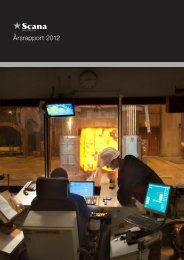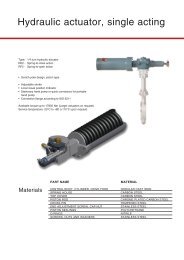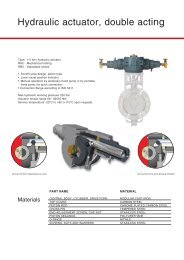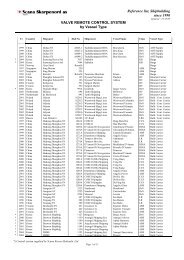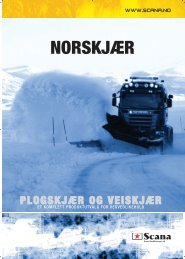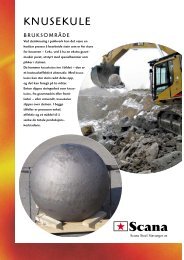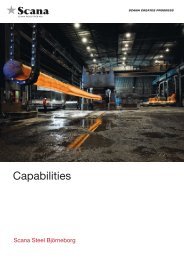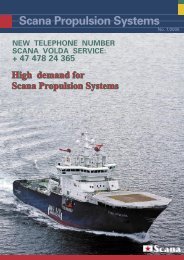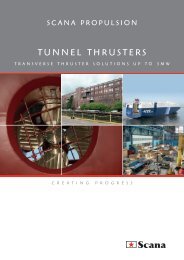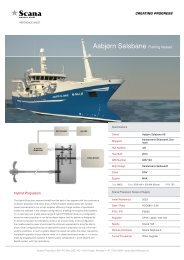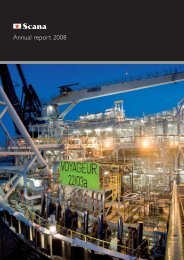Annual Report 2010 - Scana Industrier ASA
Annual Report 2010 - Scana Industrier ASA
Annual Report 2010 - Scana Industrier ASA
You also want an ePaper? Increase the reach of your titles
YUMPU automatically turns print PDFs into web optimized ePapers that Google loves.
74<strong>Annual</strong> <strong>Report</strong> <strong>2010</strong> <strong>Scana</strong> <strong>Industrier</strong> <strong>ASA</strong>Associated companies: Sale Purchase Receivables Liability<strong>Scana</strong> Korea Hydraulic Ltd <strong>2010</strong> 32 676 237 3 899 92009 49 945 138 11 967 88Jørpeland Kraft AS <strong>2010</strong> 1 552 2 618 7 886 2 3992009 2 532 5 509 334 402Motala Verkstad AB <strong>2010</strong> 815 12 753 0 1 1472009 4 267 27 515 183 3 491<strong>Scana</strong> Wikov AS <strong>2010</strong> 21 0 0 02009 32 0 6 0Stingray Inc. <strong>2010</strong> 0 2 095 0 1162009 0 2 384 0 552PetroParts JV <strong>2010</strong> 202 0 0 02009 0 0 0 0Related-party transactions are carried out at the assumed market price. Outstanding receivables and liabilities are unsecured short-terminterest-free items. Settlements are in cash. The group has not issued any guarantees to its related parties. No provisions have been made forunsecured receivables as at 31 December <strong>2010</strong>.Note 22. Financial riskCentralised risk management<strong>Scana</strong> has a centralised finance function. The most important taskis to secure the group’s room to manoeuvre in the short and longterm. Hedging of currency, interest and electricity price exposure iscarried out in accordance with the group’s policy and routines. This isdone centrally by the Finance Department on the basis of the needsreported by the operational units.Financial riskThe group’s activities are exposed to financial market risk, whichmainly affects exchange rate risk, interest rate risk and fluctuationsin the price of electricity. Furthermore, the group (primarily the steelarea) is also exposed to development in other raw material pricessuch as scrap steel and alloys. <strong>Scana</strong> aims to reduce the risk linkedto currency, interest and electricity prices by means of derivatives.The group has chosen not to hedge against any fluctuations in otherraw material prices, since <strong>Scana</strong> believes that any increases in theseprices can mainly be offset by increased sale prices, although with acertain time lag.Currency riskThe group is exposed to exchange rate fluctuations since large partsof the production, purchasing and sales take place abroad and/or inforeign currency. The group’s internal banking function continuouslymonitors and reports the group’s currency positions. The currency riskis estimated for each foreign currency and takes account of assets,debts and probable purchases and sales in the relevant currency.The company tries to reduce the currency risk by means of forwardcontracts, deposits and/or borrowings in the relevant currencies. Themain risks linked to currency in the group are related to future salespayments and the group’s assets in foreign subsidiaries.Interest rate risk:The group’s interest rate risk is mainly linked to the group’s debtportfolio. The risk is managed at group level. The group aims tooffset major effects linked to changes in the market rate. <strong>Scana</strong> hastherefore tied parts of the debt portfolio to fixed interest rates in orderto curb short-term fluctuations in the market rate. The group’s strategyis for at least 40 per cent of the company’s interest-bearing debt to besecured with fixed interest rates. <strong>Scana</strong>’s greatest exposure to interestrate fluctuations is related to STIBOR.Price risk on electricity:The group has major electricity costs in relation to the productionof its goods, mainly in the steel segment. <strong>Scana</strong> protects itself fromfluctuations in electricity prices by buying electricity derivatives forSwedish subsidiaries and through <strong>Scana</strong> Steel Stavanger AS. Thegroup has an agreement with Vattenfall Power Management AB toadminister <strong>Scana</strong>’s electricity derivatives with the aim of hedgingthe future electricity prices that need to be paid in Sweden anda Norwegian company. The estimated electricity consumption ishedged by up to 100 per cent for the coming months, while thehedged share of estimated consumption gradually becomes lower forperiods further into the future.Liquidity riskSecuring good financial room to manoeuvre is an important aim ofthe group. As a result of the international financial crisis, a numberof measures have been implemented to reduce the financial risk,particularly through closer follow-up of liquidity projections andprogrammes linked to reducing the working capital.The group monitors the liquidity situation in the short and long termthrough active dialogue with its subsidiaries. At the end of <strong>2010</strong>, thegroup had sufficient liquidity reserves and good credit lines. Thegroup has unused credit facilities which amount to NOK 143 millionand consist of the rolling credit facility corresponding to NOK 13million and an overdraft facility of NOK 130 million. Cash included inthe groups cash pool was NOK 60 million (ref. note 15). In total, theliquidity reserve for the group as at 31 December <strong>2010</strong> was henceNOK 203 million. The financial covenant of the syndicate loan linked tothe liquidity reserve is set at a minimum of NOK 100 million. The groupbelieves the liquidity risk to be limited.The group’s prognosis for growth in liquid reserves shows a positivetrend. During the refinancing in 2007 the Group got very favorableterms and conditions with tough covenant requirements. The Groupwas in breach of covenants in the fourth quarter <strong>2010</strong> and first quarter2011 and was granted a waiver from the lenders before the respectivebalance sheet dates. It is possible that the Group will be in breach ofcovenants in the second quarter of 2011. Through positive communicationwith the lenders the Group expects to be granted a waiver.Credit risk:The group has guidelines for ensuring that orders are not enteredinto with customers who have had major payment problems andwhere outstanding amounts do not exceed defined credit limits. Themaximum risk exposure is represented by the capitalised value ofthe financial assets, including derivates, in the balance sheet. Thecustomer in derivative dealings is DnBNor and Nordea, as well asVattenfall Power Management AB, and is subject to inspection byfinance inspectors in Sweden. The credit risk linked to derivates isregarded as low. The group regards its greatest risk exposure to bethe recognised value of trade receivables (see note 13) and otherreceivables (see note 14).



